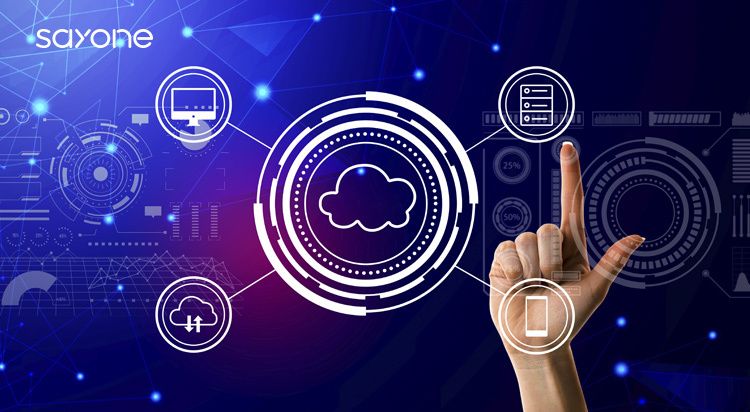
Subscribe to our Blog
We're committed to your privacy. SayOne uses the information you provide to us to contact you about our relevant content, products, and services. check out our privacy policy.

Jomin Johnson September 4, 202410 min read

Generating table of contents...
Microservices architecture has become the go-to approach for building complex and scalable systems. However, with the benefits of microservices come unique challenges, particularly when it comes to understanding what's happening within the system.
This is where observability comes in – the ability to gain insights into the internal state of a system by examining its outputs.
Microservices observability refers to the ability to gain insights into the internal state of a microservices system by examining its external outputs. It goes beyond traditional monitoring, which focuses on tracking predetermined metrics and logs, and instead provides a holistic view of the system's health and performance in real time.
In a microservices architecture, observability is important for identifying and resolving issues quickly. Unlike traditional monolithic architectures, where the entire system is in a single codebase, microservices are distributed across multiple services, making it difficult to get a comprehensive overview of the system.
Observability helps teams to navigate this complexity by providing a deeper understanding of the system's behavior and performance
In Microservices management Observability and monitoring are two distinct concepts.
Monitoring involves tracking predefined metrics and logs to identify problems and anomalies, providing insights into a system’s current state and alerting administrators when thresholds are exceeded or anomalies are detected.
On the other hand, observability goes beyond monitoring by interpreting what data reveals about the internal state of an application, allowing teams to understand the behavior of microservices under various conditions and gain insights that can help improve the system's reliability, performance, and user satisfaction.
Observability for microservices requires the ability to understand the state of each service instance and correlate observability data from multiple services to gain insight into the health of the application as a whole.
It involves collecting comprehensive telemetry data, such as metrics, logs, and traces, which allows teams to ask arbitrary questions about the system's state and behavior without needing to define what to look for in advance.
This approach is particularly crucial for distributed systems due to their inherent complexity and dynamic nature, addressing essential contexts of microservice applications like complexity management and communication mesh monitoring between services.
Can your current monitoring tools provide a complete picture of your microservices architecture, or are there blind spots that could lead to unforeseen issues?
In many cases, traditional monitoring tools fall short in providing a comprehensive view of microservices systems. They might alert you to symptoms of problems but fail to offer the depth of information needed to diagnose and resolve complex issues.
This is where observability steps in, offering a more holistic approach that not only identifies problems but also provides the necessary context to understand and address them effectively.

Microservices observability is crucial for understanding the complex interactions within a distributed system. It provides insights into the system's performance.
The key pillars of microservices observability are the foundational elements that enable comprehensive visibility into these systems.
Logs are detailed records of events that occur within the system. They provide context on what happened and when, making them essential for diagnosing issues. Logs can be structured, unstructured, or binary, with structured logs becoming increasingly popular due to their ease of querying and analysis.
In microservices, logs help trace the flow of requests and identify errors or anomalies in the system's operations. Logs can capture data on user interactions, system errors, and network communications, providing a granular view of system activities.
Effective log management involves collecting logs from various sources, storing them in a centralized location, and using tools to analyze and visualize the data. This helps in identifying patterns, detecting anomalies, and troubleshooting issues more methodically.
Metrics are numerical representations of system performance over time. They include data such as CPU usage, memory consumption, response times, and error rates. Metrics are crucial for monitoring the health and performance of microservices, allowing teams to track trends and detect issues before they escalate.
Metrics provide a high-level view of system performance, enabling quick assessments of whether the system is operating within expected parameters.
Metrics can help identify if a service is experiencing high latency, memory leaks, or increased error rates, prompting immediate action to mitigate these issues.
By using metrics, teams can set up alerts and dashboards to monitor key performance indicators (KPIs) and service-level objectives (SLOs), ensuring that the system meets its operational and business goals.
Traces follow the journey of a request through the microservices architecture, capturing data at each step or span. This helps in understanding the path of a request and identifying bottlenecks or failures in the process.
Tracing is particularly important in microservices due to the distributed nature of the architecture, where a single request might interact with multiple services. By tracing requests, teams can visualize the flow of data and identify where issues occur, whether it's in a specific service, database query, or network call.
Distributed tracing tools can aggregate trace data from multiple services, providing a unified view of request flows and performance bottlenecks. This enables teams to optimize system performance and reduce latency.

Observability in microservices is essential for understanding how your system behaves. It helps get a clear picture of what's happening inside your system, so you can quickly spot and fix any issues.
Here are some key design patterns that used for observability in microservices architectures:
Distributed tracing is essential for tracking requests as they traverse through various microservices. This pattern helps identify performance bottlenecks and understand the flow of requests across services.
Each request is tagged with a unique identifier, allowing developers to trace its path and analyze the time spent in each service. Tools like Zipkin and Jaeger are commonly used for implementing distributed tracing.
In a microservices architecture, it can be challenging to identify the root cause of performance issues, as requests often span multiple services.
How Distributed Tracing Helps: Distributed tracing provides end-to-end visibility into how requests are processed across different services. By capturing detailed timelines of request flows, it helps pinpoint bottlenecks and latency issues, ultimately allowing for optimization of the application's performance.
This insight is crucial for understanding complex interactions and dependencies between services, enabling faster troubleshooting and more effective resource allocation.
How can you ensure that your distributed tracing system scales with your growing microservices architecture?
To ensure scalability, consider implementing a tracing system that uses a probabilistic sampling approach, which captures a representative subset of requests without overwhelming the system.
This approach allows for systematic tracing without compromising performance.
A Health Check API provides a simple way to monitor the health of microservices. This pattern involves creating an endpoint that returns the current status of a service, indicating whether it is operational or facing issues.
It helps in ensuring that only healthy instances receive traffic, thereby improving system reliability. Implementing health checks can prevent routing requests to services that are not ready to handle them.
In a dynamic environment, services may become unavailable due to various reasons such as network issues or deployment failures.
How Health Check API Helps: The Health Check API acts as a quick diagnostic tool that continuously monitors the status of services. By providing real-time information about service availability, it helps in isolating and managing unhealthy instances, ensuring that traffic is directed only to operational services. This proactive monitoring helps maintain system uptime and reliability.
How can you ensure that your health check API is not overwhelmed by frequent checks, leading to performance degradation?
To avoid overwhelming the health check API, consider implementing a caching mechanism that stores the health status of services for a short period. This approach reduces the load on the API while still providing up-to-date health information.
Log aggregation centralizes logs from various services into a single repository, making it easier to search, analyze, and set alerts. This pattern helps in troubleshooting by providing a comprehensive view of logs across the system.
Tools like the ELK stack (Elasticsearch, Logstash, Kibana) and Fluentd are popular choices for log aggregation.
In a microservices architecture, logs are scattered across multiple services, making it difficult to diagnose issues.
How Log Aggregation Helps: By centralizing logs, log aggregation provides a unified view of all service activities, enabling easier search and analysis.
This pattern helps in quickly identifying patterns and anomalies, streamlining the troubleshooting process, and reducing the time needed to sort out issues. It also facilitates collaboration across teams by providing a shared source of truth.
How can you ensure that your log aggregation system handles the volume and variety of logs generated by your microservices?
To handle the volume and variety of logs, consider implementing a log aggregation system that uses a scalable and flexible architecture, such as a cloud-based logging service. This approach allows for easy scaling and adaptation to changing log volumes.
Audit logging involves recording user actions and system changes to maintain a detailed history of events. This pattern is crucial for security and compliance, as it provides a trail of activities that can be reviewed if issues arise.
Audit logs help in understanding the sequence of actions leading to a problem and are essential for forensic analysis.
In a microservices architecture, it can be challenging to maintain a comprehensive audit trail, as user actions and system changes are scattered across multiple services.
How Audit Logging Helps: Audit logging ensures that all significant actions and changes within the system are recorded, providing a detailed trail that can be used for compliance and security audits.
This pattern upgrades the security posture by making actions traceable and verifiable, helping to quickly identify and address unauthorized activities.
How can you ensure that your audit logging system captures all relevant user actions and system changes without overwhelming the system?
To ensure comprehensive audit logging, consider implementing a logging system that uses a standardized logging format and includes mechanisms for filtering and sampling logs.
Exception tracking focuses on capturing and managing exceptions across services. This pattern involves reporting exceptions to a centralized service that can de-duplicate and alert developers.
By tracking exceptions, teams can quickly identify and find answers to persisting issues, which helps improve the stability of the system.
In a microservices architecture, exceptions can occur in any service, making it difficult to identify and deal with issues.
How Exception Tracking Helps: Exception tracking provides a centralized view of all exceptions, allowing for quicker identification and resolution of issues.
By de-duplicating and prioritizing exceptions, this pattern helps developers focus on the most critical problems, reducing downtime and improving system reliability.
It also aids in proactive error management by providing insights into recurring issues and potential areas for improvement.
How can you ensure that your exception tracking system provides actionable insights, rather than just a flood of error messages?
To provide actionable insights, consider implementing an exception tracking system that includes features such as error grouping, prioritization, and contextual information.
This approach allows developers to focus on the most critical issues and settle a plan of action efficiently.
At SayOne, we specialize in helping organizations like yours build resilient and efficient microservices architectures. Our team of experts is dedicated to providing tailored solutions that meet your unique needs. Whether you're looking to implement distributed tracing, health check APIs, log aggregation, audit logging, or exception tracking, we're here to guide you every step of the way.
Get in touch with us today to discover how SayOne can help you with your microservices observability and drive your business forward.

We're committed to your privacy. SayOne uses the information you provide to us to contact you about our relevant content, products, and services. check out our privacy policy.

About Author
Head of AI-Retail @ SayOne Technologies|Project Manager | Product Owner - CSPO®| Lead Business Analyst

We collaborate with visionary leaders on projects that focus on quality